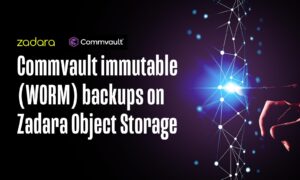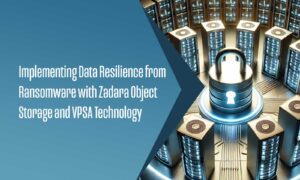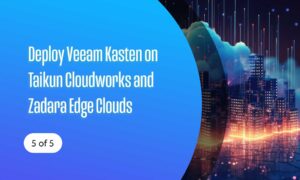If you’re looking to further expand your enterprise cloud storage knowledge, join us for Tech Tip Tuesdays! When comparing the offerings of various cloud service and storage vendors, there are a lot of terms, acronyms, and outright jargon. While part of the issue is simply that cloud computing is a rather complex subject, and there are an overwhelming number of different types of services and products available, there is another side to the coin. At times, it may even seem that vendors are intentionally trying to confuse the customer. Here is a simple, enterprise cloud storage glossary that you can bookmark for future reference.
Enterprise Storage
Though there are many enterprise storage solutions available on premise, moving to the cloud does not always guarantee that you maintain those same capabilities.
Enterprise storage is a catch-all term for storage solutions that are scalable, flexible, and reliable enough to be used for large businesses, where downtime is costly in terms of revenue and reputation. Not all “cloud storage” is “enterprise storage”. The storage industry has spent decades building enterprise storage capabilities for on-premise offerings. If you are moving to the cloud, you should ensure that the cloud storage solution you choose has the same capabilities you have learned to rely on with your on-premise storage.
Direct Attached Storage (DAS)
DAS is the foundation upon which SAN and NAS are deployed. It connects directly to the LAN (Local Area Network), and includes storage devices (RAM, flash, SCSI, SATA, SAS, etc.).
Network Attached Storage (NAS)
NAS is a server that is able to deliver storage via a LAN. Where enterprise-grade storage is involved. NAS is most commonly used in conjunction with SAN (see next entry), and utilizes RAID (Redundant Arrays of Independent Disks), as well as security and data protection features, like mirroring and/or replication. In a NAS environment, storage is accessed via files. Again, not all cloud storage solutions support file-based NAS storage.
Storage Area Network (SAN)
SAN is a network of high-speed storage devices that also serves as a connection among the various storage devices and servers. It utilizes block-level storage that is accessed by the various applications that are running on the servers on the network. Much like NAS storage above, not all cloud offerings support block-based SAN configurations. Be sure that your cloud offering supports the storage type you require.
Cloud Washing

Cloud washing is the act of washing existing products with cloud-colored detergent — trying to make a product sound like it is a cloud-based solution, when it actually isn’t.
This is a term used to express the practice of calling a product or service “cloud” when it really is not a cloud product. It became popular when cloud computing took off, and a lot of vendors wanted to capitalize on the buzz.
Green Cloud
One of the strong selling points for the cloud is the ability for businesses to reduce their environmental footprint. It lowers power consumption, reduces organizational waste, and allows for other environmentally-friendly improvements. The “green cloud” is primarily a marketing term to help sell the green, or environmentally-friendly, aspect of their cloud products.
Docker/Containerization
Docker is a free, open-source software system that makes it easier to develop and deploy applications by utilizing a technology called “containerization”. Containers give software developers the ability to combine, or package, an application with all of its various parts. Like a virtual machine, it is a way for developers to make sure that the application will run on any machine, but unlike a virtual machine, it does not require creating an entire virtual OS. It boosts performance and reduces the footprint of an application. Docker containers are powerful tools to increase performance and reduce application latency. If you require Docker container support, make sure that your cloud-based storage solution provides this capability.
Content Delivery Network (CDN)
CDN is an acronym that means distributing a lot of servers around in various locations and letting everyone use the one that’s closest to them. It improves the performance of websites by creating physical proximity to the hardware. For example, if you’re in Beijing, you’re using a different server to access Facebook than you would in Glasgow or San Antonio.
A CDN is a distributed system of servers, situated in various physical locations, which are set up in a way that allows the clients to gain access to whichever server is closest to them. This configuration improves the speed and performance of Web-based content like webpages.
Hybrid Cloud
The hybrid cloud is a combination of utilizing a private cloud and a public cloud. These two cloud infrastructures operate totally independently of one another, and use software to integrate in order to share data and applications. Many companies that believe they are using the private cloud are actually using the hybrid cloud. In some cases, the hybrid cloud can also include on-premises storage solutions. There are tremendous benefits to being able to locate some of your data on-premise in a private cloud and some of your data in a public cloud. If you require this flexibility, find a cloud storage provider that can offer a common solution both in the cloud, on-premise and in hybrid configurations.
Multi-Tenancy and Resource Isolation
Multi-tenancy is a key concept with cloud solutions. In essence, you can think of multi-tenancy in terms of a hotel. Very few of us can afford to rent an entire hotel when we travel. The benefit of the hotel, is that you have a cleaning service, a full restaurant providing room service, a workout facility, and so forth. With multi-tenancy, you have hundreds of people sharing the cost of all of these onsite services and it becomes very cost-effective. However, what happens when 200 people all order room service at 8:00am? How is the water pressure, when everyone tries to take a shower at the same time? What about the noisy neighbor in the room next door? The same thing happens when applications are moved to the cloud. We gain the economic benefit of sharing the cost of the infrastructure, but with many cloud solutions, your data and 50 other companies data share the same disk drives, network connections and processors. Your performance can be severely impacted by your neighbor’s applications.
Ask your cloud provider if they provide “resource isolation”. Make sure that your data resides on it’s own disk drives and you have your own processors and network connections to guarantee predictable performance and the highest levels of security. If your cloud vendor does provide dedicated resources, then you should get the benefits of multi-tenancy, but with a single-tenant experience. This is the best of both worlds. You should not have to suffer through poor and inconsistent performance to enjoy the economic benefits of multi-tenancy.
Now, when you are making a cloud storage comparison, you can choose wisely, knowing what the terms mean when vendors toss them around. Would you like to know more about cloud architectures, and how these solutions can impact your business network? Download the whitepaper: Software Defined Storage vs. Traditional SAN and NAS Storage now.








